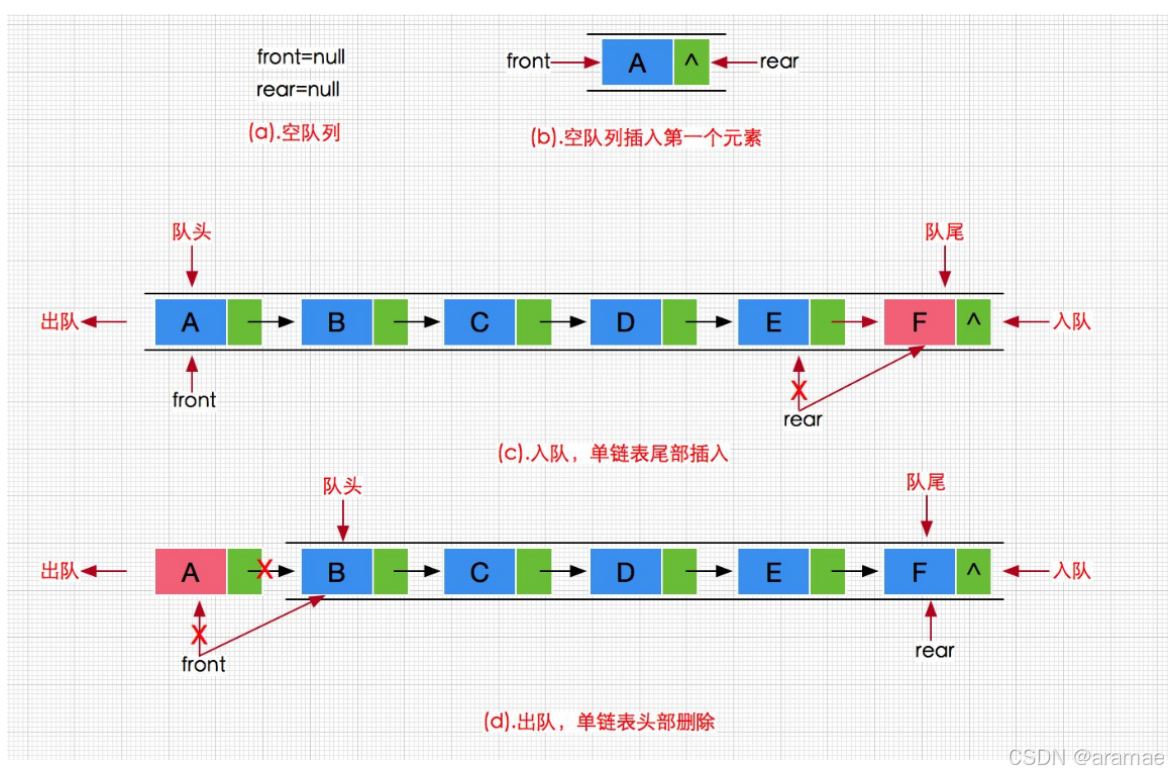大话数据结构之<队列>
引言:队列是一种先进先出(First In First Out, FIFO)的线性数据结构,只允许在队尾(rear)插入元素,在队头(front)删除元素。本章介绍队列,包括其实现。
1. 队列的概念及结构
队列:只允许在一端进行插入数据操作,在另一端进行删除数据操作的特殊线性表,队列具有先进先出 FIFO(First In First Out) 入队列:进行插入操作的一端称为队尾 出队列:进行删除操作的一端称为队头

2. 队列的实现
队列也可以数组和链表的结构实现,使用链表的结构实现更优一些,因为如果使用数组的结构,出队列在数 组头上出数据,效率会比较低。

下面实现一个动态队列(链表)
#include<stdio.h>
#include<stdlib.h>
#include<stdbool.h>
#include<assert.h>
//队列性质:先进先出 ///* 1.队列初始化2.队列销毁3. 入对列4.出队列5.判空6.返回队列长度 7.返回队头数据8.返回队尾数据
*/
//用单链表实现队列
//使用两个结构体
//一个表示链表的节点的构成
//一个用来描述队列
typedef int QDatatype;//队列的节点
typedef struct QueueNode
{struct QueueNode* next;QDatatype data;
}QNode;//描述队列
typedef struct Queue
{QNode* head;//队头位置 QNode* tail;//队尾位置 int size;//队列长度
}Queue;//判空
bool QueueEmpty(Queue* pq)
{assert(pq);return pq->size == 0;
}//初始化
void QueueInit(Queue* pq)
{assert(pq);pq->head = NULL;pq->tail = NULL;pq->size = 0;
}//销毁队列
void QueueDestroy(Queue* pq)
{assert(pq);assert(!QueueEmpty(pq));QNode* cur = pq->head;while(cur){QNode* next = cur->next;free(cur);cur = NULL;cur = next; } pq->head = pq->tail = NULL;pq->size = 0; }//入队列
void QueuePush(Queue* pq, QDatatype x)
{//创建新的节点 QNode* newnode =(QNode*)malloc(sizeof(QNode));if(newnode == NULL){perror("malloc fail");return ;} newnode->data = x;newnode->next = NULL;if(pq->head==NULL){assert(pq->tail == NULL);pq->head = pq->tail = newnode; }else{pq->tail->next = newnode;pq->tail = newnode;}pq->size++;
}//出队列
void QueuePop(Queue* pq)
{assert(pq);assert(pq->head!=NULL);if(pq->head->next == NULL){free(pq->head);pq->head = pq->tail = NULL; }else{QNode* next = pq->head->next;free(pq->head);pq->head = next;}pq->size--;} //返回队列长度
int QueueSize(Queue* pq)
{assert(pq);return pq->size;
}//返回队头数据
QDatatype QueueFront(Queue* pq)
{assert(pq);assert(!QueueEmpty(pq));return pq->head->data;}//返回队尾数据
QDatatype QueueBack(Queue* pq)
{assert(pq);assert(!QueueEmpty(pq));return pq->tail->data;
}//打印队列
void QueuePrint(Queue* pq)
{assert(pq);assert(!QueueEmpty(pq));QNode* cur = pq->head;while(cur){QNode* next = cur->next;printf("%d ",cur->data);cur =next;}}int main()
{Queue pq;//定义一个队列//下面来实现一下队列的基本功能 //1.初始化QueueInit(&pq);//2.向队列中放入数据//这里试放8个QueuePush(&pq, 1);//打印出来看一下 //1printf("%d\n", QueueFront(&pq)); //继续放 QueuePush(&pq, 2);QueuePush(&pq, 3);QueuePush(&pq, 4);QueuePush(&pq, 5);QueuePush(&pq, 6);QueuePush(&pq, 7);QueuePush(&pq, 8);//这里我们可以再添加一个函数,用来打印整个对列//便于我们观察整个队列的变化 QueuePrint(&pq); printf("\n");//3.出队列 ,这里选择出四个数据 QueuePop(&pq);QueuePop(&pq);QueuePop(&pq);QueuePop(&pq);//再观察队列里的数据QueuePrint(&pq);printf("\n");QueuePop(&pq);//观察此时 队头,队尾数据和队列长度// 6 8 3printf("%d ",QueueFront(&pq));printf("%d ",QueueBack(&pq)); printf("%d ",QueueSize(&pq)); return 0;} 